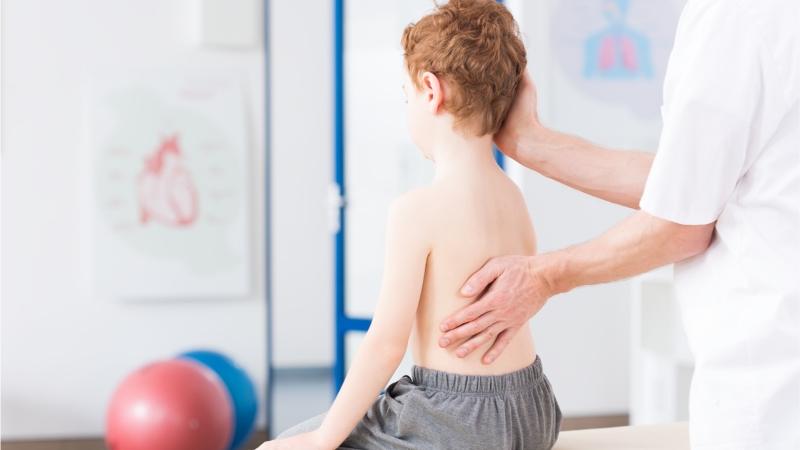
Centers of Excellence

MITERA Children’s Hospital has established the Spine Center to monitor conditions of the spine and offer effective treatment.
Conditions of the spine in children and adolescents are much more frequent than generally anticipated. In Greece, some 1500 children visit their pediatrician annually for simple or complex spine-related problems. Adolescent idiopathic scoliosis and kyphosis are probably the most familiar. However, a significant part of the population have the same clinical findings from different causes (early-onset idiopathic infantile or childhood scoliosis, congenital scoliosis, neuromuscular scoliosis or syndromic scoliosis) or complain of pain as a result of early degenerative lesions, injury, inflammation or malignant conditions. Modern conservative & surgical treatment in children and adolescents with spinal conditions ensures quality of life (and in certain cases much better quality) for patients and their families.
Global experience has shown that optimal results are directly linked to proper monitoring and suitable treatment by specialized multidisciplinary teams of doctors and health professionals at dedicated centers. These centers do not just stay up-to-date in terms of scientific advancements, but also keep their ear to the ground and feel the pulse of the people and their everyday lives. Wherever possible, they continue conducting onsite scientific research, producing knowledge and experience that benefits the patients in question.
The Spine Center team is made up of surgeons with proven interest and long experience in Greece and aboard, who are surrounded by other specialists, physiotherapists, orthotic therapists, nurses and psychologists.
Our Facilities
Operating Rooms: They meet all the standards, are equipped with the latest technology and are staffed by qualified nurses.
Pediatric Intensive Care Unit (ICU) and High Dependency Unit (HDU): They are equipped with the latest medical devices, offering hospitalization in a dedicated environment designed to limit hospital infections, with 24-hour monitoring that ensures the safety of young patients.
Imaging Departments: They provide all the latest technology in imaging equipment, ensuring specialized care and safety.
Congenital Conditions
• Congenital kyphoscoliosis or lordosis (hemivertebra, vertebral bars, sacral agenesis)
• Congenital spinal stenosis
• Congenital deformities of the cervical spine and the craniovertebral junction
• Dysraphism / Spina bifida
• Skeletal dysplasias
Developmental Conditions
• Torticollis
• Idiopathic neonatal, infantile, childhood & adolescent scoliosis
• Scheuermann’s kyphosis
• Spondylosis / Spondylolisthesis
• Adolescent lumbar disc herniation
Conditions from Neurological & Metabolic Disorders & Syndromes
• Neuromuscular kyphoscoliosis (cerebral palsy, Charcot-Marie-Tooth disease, spinal muscular atrophy, myelomeningocele, poliomyelitis, etc)
• Spinal deformity in:
– Neurofibromatosis, presence of Chiari malformation
– Connective tissue disorders (arthrogryposis, Marfan syndrome, Ehlers-Danlos syndrome)
– Muscular dystrophy (Duchenne, Becker, congenital, etc)
– Osteochondrodysplasia (dwarfism): Achondroplasia, spondyloepiphyseal dysplasia, osteogenesis imperfecta, Noonan syndrome
– VACTERL association
– Neurodevelopmental disorders: Angelman syndrome, Smith-Magenis syndrome, Prader-Willi syndrome, Rett syndrome, Smith-Lemli-Opitz syndrome, Friedreich’s ataxia
– Trisomies: 21 (Down syndrome) etc
– Mucopolysaccharidoses: Morquio syndrome, Gaucher disease, etc
• Idiopathic juvenile osteoporosis
Inflammations & Inflammatory Conditions
• Discitis / Osteomyelitis
• Spinal tuberculosis
• Rheumatic diseases
Neoplasms
• Primary and metastatic spinal tumors
• Deformities following excision of spinal neoplasms
Trauma
• Instability of the upper cervical spine (e.g. in Down syndrome)
• Injuries to the cervical, thoracic, lumbar spine and the sacral bone
• Injury to the spinal cord and post-traumatic spinal deformities
• Anterior and posterior spinal access along the entire length of the spine (from skull base to pelvis)
• Anterior or posterior spinal osteotomy (in large rigid curves)
• Vertebral corpectomy (anterior or posterior, e.g. for congenital scoliosis)
• Growing rods and modified Luque trolley techniques for continuous spinal growth when correcting a deformity (e.g. early-onset scoliosis) or for limiting the risk of respiratory infections in neuromuscular deformities
• Minimally invasive surgery in special cases
• Thoracoscopic release of spinal deformities
• Thoracoplasty to correct the hump
• Kyphectomy to restore sagittal spinal alignment
The Spine Center is on-call 24/7 at the MITERA Children’s Hospital Outpatient Clinic.